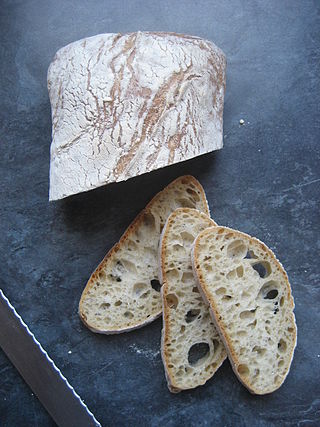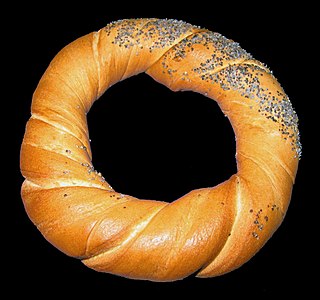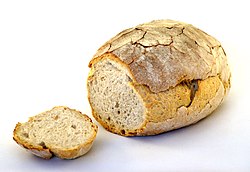
Bread is a staple food prepared from a dough of flour and water, usually by baking. Throughout recorded history and around the world, it has been an important part of many cultures' diet. It is one of the oldest human-made foods, having been of significance since the dawn of agriculture, and plays an essential role in both religious rituals and secular culture.

Pastry is baked food made with a dough of flour, water and shortening that may be savoury or sweetened. Sweetened pastries are often described as bakers' confectionery. The word "pastries" suggests many kinds of baked products made from ingredients such as flour, sugar, milk, butter, shortening, baking powder, and eggs. Small tarts and other sweet baked products are called pastries as a synecdoche. Common pastry dishes include pies, tarts, quiches, croissants, and pasties.

A bagel is a bread roll originating in the Jewish communities of Poland. It is traditionally shaped by hand into a roughly hand-sized ring from yeasted wheat dough that is first boiled for a short time in water and then baked. The result is a dense, chewy, doughy interior with a browned and sometimes crisp exterior.

Dough is a thick, malleable, sometimes elastic paste made from grains or from leguminous or chestnut crops. Dough is typically made by mixing flour with a small amount of water or other liquid and sometimes includes yeast or other leavening agents, as well as ingredients such as fats or flavorings.

Lebkuchen, Honigkuchen or Pfefferkuchen, are a honey-sweetened German cake molded cookie or bar cookie that has become part of Germany's Christmas traditions. It is similar to gingerbread.

Ciabatta is an Italian white bread made from wheat flour, water, salt, yeast and olive oil, created in 1982 by a baker in Adria, province of Rovigo, Veneto, Italy, in response to the popularity of French baguettes. Ciabatta is somewhat elongated, broad, and flat, and is baked in many variations, although unique for its alveolar holes. Ciabatta is made with a strong flour and uses a very high hydration dough.

Rye bread is a type of bread made with various proportions of flour from rye grain. It can be light or dark in color, depending on the type of flour used and the addition of coloring agents, and is typically denser than bread made from wheat flour. Compared to white bread, it is higher in fiber, darker in color, and stronger in flavor.
The Chorleywood bread process (CBP) is a method of efficient dough production to make bread quickly, producing a soft, fluffy loaf. It was developed by Bill Collins, George Elton and Norman Chamberlain of the British Baking Industries Research Association at Chorleywood in 1961. As of 2009, 80% of bread made in the United Kingdom used the process. Compared to the older bulk fermentation process, the CBP is able to use lower-protein wheat, and produces bread in a shorter time.

The Basler Läckerli is a traditional hard spice biscuit originating from Basel, Switzerland. It is made of honey, hazelnuts, almonds, candied peel, and Kirsch. After baking in a thin layer, the still hot dough is topped with a sugar glaze and cut into rectangular pieces.

Vienna bread is a type of bread that is produced from a process developed in Vienna, Austria, in the 19th century. The Vienna process used high milling of Hungarian grain, and cereal press-yeast for leavening.

Berner Haselnusslebkuchen are Lebkuchen – traditional Christmas cakes – from Berne, Switzerland. Made from ground hazelnuts, they are not to be confused with the Berner Honiglebkuchen, another Bernese specialty.
Burebrot, Bauernbrot, Pain paysan or Pane del nonno is a bread made in Switzerland. Unlike most other breads, which are mainly composed of flour, yeast and water, the Burebrot also contains milk.
Zürcher Murren, also called pain bernois, Bernerweggen, Spitzweggen, geschnittene Weggli or Zackenweggen are a type of bread roll traditionally made in the German-speaking part of Switzerland and, more rarely, in the Romandy.

The pane ticinese is a white bread traditionally made in the Swiss canton of Ticino, but also available in the rest of Switzerland, where it is known as "Bread of Ticino". In Ticino, it is referred to by a number of names specific to the region, including pane riga, reale or lireta.
Blue cake is a flaky pastry that is a specialty of the Frutig valley in the Bernese Oberland, Switzerland. It consists only of puff pastry with no filling or other ingredients. Despite its name, it is not blue.

No-knead bread is a method of bread baking that uses a very long fermentation (rising) time instead of kneading to form the gluten strands that give the bread its texture. It is characterized by a low yeast content and a very wet dough. Some recipes improve the quality of the crust by baking the bread in a Dutch oven or other covered vessel.

Bread is a staple food throughout Europe. Throughout the 20th century, there was a huge increase in global production, mainly due to a rise in available, developed land throughout Europe, North America and Africa.

An obwarzanek krakowski is a braided ring-shaped bread that is boiled and sprinkled with salt and sesame or poppy seeds before being baked. It has a white, sweetish, moist and chewy crumb underneath a crunchy golden-brown crust. Traditionally sold from street carts, it is a popular snack in the Polish city of Kraków, where it has the status of a regional food with protected geographical indication. It is closely related to, but distinct from, bagels, bubliks and pretzels.

Wähe is a baked dish typical of Swiss and Alemannic (German) cuisine. A wähe consists of a casing and a topping of a custard enveloping either fruit, vegetables or cheese. The custard and fruits or vegetables are baked together. The preparation is thus very similar to that of the French quiche or tarte.

















